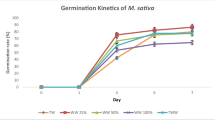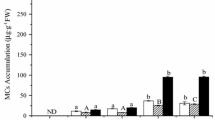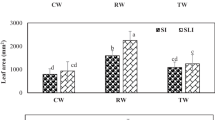Abstract
The sand medium experiment was conducted in the laboratory with the aim of evaluating the suitability of municipal wastewater (treated and untreated) at different concentrations (0, 2.5, 5, 10, 25, 50, and 100%) for irrigation purposes on seed germination, seedling performance, nutrient uptake, and chlorophyll content of rice (MR220). The utilization of municipal wastewater for irrigation purposes has developed an important way to exploit the nutrients it contains. The study indicated a significant (P < 0.05) difference between untreated and treated municipal wastewater for seedling length (SL), root volume (RV), root surface area (RSA), seedling vigor index (SVI), and root: shoot ratio (R : S) while no significant different was observed between untreated and treated municipal wastewater for germination percentage (GP) and percentage phytotoxicity (PPT). The municipal wastewaters had stimulatory effect on the rice seeds at lower wastewater concentrations (< 25%) while inhibitory effect was observed at higher wastewater concentrations (> 50%). N, P, K, Ca, Mg, Zn, Fe, Cu, and Mn were high in the untreated municipal wastewater compare to treated municipal wastewater. Seedlings irrigated with untreated municipal wastewater have high seed germination, seedling performance with high nutrient uptake compare to treated municipal wastewater. The municipal wastewaters showed inhibitory effect on chlorophyll content. The inhibition effect was observed at > 50% concentration of both untreated and treated municipal wastewater while promoting effects were observed at lower (< 25%) concentration. The rice MR220 variety showed better growth resistance, tolerance, and adaptability to wastewater. This can be due to its excellent genetic makeup and capacity to sustain the toxicity. Conclusively, municipal wastewater could be recommended as a good source of water and nutrient for seed germination and seedling performance.
Similar content being viewed by others
Abbreviations
- MR:
-
Malaysian rice
- N:
-
nitrogen
- P:
-
phosphorous
- K:
-
potassium
- Ca:
-
calcium
- Mg:
-
magnesium
- Zn:
-
zinc
- Fe:
-
iron
- Cu:
-
cupper
- Mn:
-
manganese
References
Abu NE, Ezeugwu SC. 2008. Risk evaluation of industrial wastewater on plants using onion (Allium cepa L.) chromosome aberration assay. Agro-Sci. 7: 242–248
Abul-Baki AA, Anderson JD. 1973. Vigour determination in soybean by multiple criteria. Crop Sci. 13: 630–637
Al-Dulaimi RI, Ismail NB, Ibrahim MH. 2012. The effect of industrial wastewater in seed growth rate: a review. Int. J. Sci. Res. Pub. 2: 1–4
Ale R, Jha PK, Belbase N. 2008. Effect of distillery effluent on some agricultural crops, a case of environmental injustice to local farmers in Khajura VDC, Banke. Scientific World 6: 68–75
American Public Health Association, American Water Works Association, and Water Environment Federation. 1998. Standard Methods for the Examination of Water and Wastewater, pp 20
Arora M, Kiran B, Rani S, Rani A, Kaur B, Mittal N. 2008. Heavy metal accumulation in vegetables irrigated with water from different sources. Food Chemist. 111: 811–815
Banerji D, Laloraya MM. 1967. Chlorophyll formation in isolated pumpkin cotyledons in the presence of kinetin and chloramphenicol. Plant Cell Physiol. 8: 263–268
Chou CH, Lin HJ. 1976. Auto intoxification mechanisums of Oryza sativa I. Phtotoxic effects of decomposing rice residues in soil. J. Chem. Ecol. 2: 353–367
Chung BY, Song CH, Park BJ, Cho JY. 2011. Heavy metals in brown rice (Oryza sativa L.) and soil after long-term irrigation of wastewater discharged from domestic sewage treatment plants. Pedosphere 21: 621–627
Cizkova R. 1990. Acidification stress of root environment as related to endogenous cytokinins and gibberellins in oak seedlings. Biol. Plantarum 32: 97–103
Coombs J, Hall DO, Long S, Scurlock J. 1985. Techniques in bioproductivity and photosynthesis. Pergamon Press
Dash AK. 2012. Impact of domestic waste water on seed germination and physiological parameters of rice and wheat. Int. J. Res. Rev. Appl. Sci. 12: 280–286
De Leo P, Sacher JA. 1970. Senescence: Association of synthesis of acid phosphatase with banana ripening. Plant Physiol. 46: 208–211
Dhanam S. 2009. Effect of dairy effluent on seed germination, seedling growth and biochemical parameter in Paddy. Bot. Res. Int. 2: 61–63
El-Nahhal Y, Yousef A, Jamal S. 2013. Bioremediation of acetochlor in soil and water systems by Cyanobacterial Mat. Int. J. Geosci. 4: 880–890
Flinn AM, Smith DL. 1967. The localization of enzymes in cotyledons of Pisum arvense L. during germination. Planta 75: 10–22
Gadallah MAA. 1995. Phytotoxic effects of industrial and sewage wastewaters on growth, chlorophyll content, transpiration rate and relative water content of potted sunflower plants. Water Air Soil Poll. 89: 33–47
Garg VK Kaushik P. 2008. Influence of textile mill waste water irrigation on the growth of sorghum cultivars. Appl. Ecol. Environ. Res. 6: 1–12
Garg VK, Priya K. 2006. Influence of short-term irrigation of textile mill wastewater on the growth of chickpea cultivars. Chem. Ecol. 22: 193–200
International Seed Testing Association. 1999. Handbook of Vigour Test Methods 3rd edition International Seed Testing Association Zurich Switzerland Supplement to Seed Sci. & Technol. V. 27
Irwin AU. 1978. Halophyte seed germination. Bot. Rev. 44: 233–264
Kaliyamoorthy J, Sathees Kannan TM, Nagarajan M. 2013. Effect of raw and biologically treated municipal waste water on growth of paddy (Oryza sativa L.). Int. J. Environ. Bioenergy, 7: 1–9
Khan IU, Khan MJ, Khan NU, Khan MJ, Rahman HU, Kalim K. 2012. Wastewater impact on physiology, biomass and yield of canola (Brassica napus L.). Pak. J. Bot. 44: 781–785
Khan MG, Danle Gl, Konji M, Thomas A, Eyasu SS, Awoke G. 2011. Impact of textile waste water on seed germination and some physiological parameters in pea (Pisum sativum L.), Lentil (Lens esculentum L.) and gram (Cicer arietinum L.). Asian J. Plant Sci. 10: 269–273
Khan SS, Sheikh KH. 1976. Effects of different level of salinity on seed germination and growth of Capsicum annam. Biologia 22: 15–25
Le Page-Degivery MT, Boillot A, Loques F, Bulard C. 1987. An analysis of the role of abscisic acid on the differential expansion and chlorophyll synthesis of the two cotyledons of dormant apple embryo in culture. Physiol. Plant. 69: 87–92
Liu D, Wang Y, Zang X, Si Q. 2002. Effect of sewage irrigation on wheat growth and its activating oxygen metabolism. J. Appl. Ecol. 13: 1319–1322
Manunatha N. 2008. Effect of industrial effluents on seed quality attributes of cereal crops. Master Thesis, University of Agricultural Sciences, Dharwad: 1–102
Medhi UJ, Talukdar AK, Deka S. 2011. Impact of paper mill effluent on growth and development of certain agricultural crops. J. Environ. Biol./Academy of Environ Biol. 32: 185
Mittelheuser GJ, Van Steveninck REM. 1971. The ultrastructure of wheat leaves. I-Changesdue to natural senescence and the effect of kinetin and ABA on detached leaves incubated in dark. Protoplasma 73: 239–252
Mojiri A, Aziz HA. 2011. Effects of municipal wastewater on accumulation of heavy metals in soil and wheat (Triticum aestivum L.) with two irrigation methods. Roman. Agric. Res. 28: 217–22
Murkumar CV, Chavan PD. 1987. Influence of water pollution on germination of gram (Cicer aeritinum L.) In Current Pollution Research in India, In PK Triveni, PK Goel, eds, Environment Publications, Karad, pp 233–238
Nawaz S, Ali SM, Yasmin A. 2006. Effect of Industrial effluents on seed germination and early growth of Cicer arientum. J. Biosci. 6: 49–54
Padhan A, Sahu SK. 2011. Effect of rice mill waste water on population, biomass, rate of reproduction and secondary production of Drawida willsi (oligochaeta) in rice field agroecosystem. International Journal of Research & Reviews in Applied Sciences, 6(2): 138–146
Paliwal K, Karuniachamy KSTK, Ananthavalli M. 1998. Effect of sewage water irrigation on growth performance biomass and nutrient accumulation in Hardwickia binata under nursery conditions. Biores. Technol. 66: 105–111
Pathrol M, Bafna A. 2013. Effect of sewage on growth parameters and chlorophyll content of Trigonella foenumgraecum (Methi). Int. Res. J. Environment Sci. 2: 5–9
Porra RJ, Thompson WA, Kriedemann PE. 1989. Determination of accurate extinction coefficients and simultaneous equations for assaying chlorophylls a and b extracted with four different solvents: verification of the concentration of chlorophyll standards by atomic absorption spectroscopy. Biochem. Biophys. Acta 975: 384–394
Rajkishore S, Vignesh N. 2012. Distillery spentwash in the context of crop production A Review. The Biascan 7: 369–375
Ramana S, Biswas AK, Singh AB. 2002. Effect of distillery effluents on some physiological aspects in maize. Biores. Technol. 84: 295–297
Rehman A, Bhatti HN, Rehman Athar Hur. 2009. Textile effluents affected seed germination and early growth of some winter vegetable crops: a case study. Water Air Soil Poll. 198: 155–163
Rodriquez MT, Gonzalez ME Linares JM. 1987. Degradation of chlorophyll and chlorophyllase in senescing barley leaves, J. Plant Physiol. 129: 369–374
Sabater B, Rodriquez MI. 1978. Control of chlorophyll degradation in detached leaves ofbarley and oat through effect of Kinetin on chlorphyllase levels, Physiol. Plant. 43: 274–276
Saravanamoorthy MD, Kumari BDR. 2007. Effect of textile waste water on morphophysiology and yield on two varieties of peanut (Arachis hypogaea L.). J. Agric. Technol. 3: 335–343
SAS. 2011. The SAS System for Windows, version 9.2, SAS Institute Inc., Cary NC, USA
Saxena RM, Kewa PF Yadav RS, Bhatnagar AK. 1986. Impact of tannery effluent on some pulse crops. Ind. J. Environ. Health 28: 345–348
Singh RP, Agrawal M, 2008. Potential benefits and risks of land application of sewage sludge. Waste Manage. 28: 347–358
Singh G, Bhati M. 2003. Growth, biomass production and nutrient composition of eucalyptus seedlings irrigated with municipal effluent in loamy soil of Indian desert. J. Plant Nutr. 26: 2469–2488
Singh PK, Deshbhratar PB, Ramteke DS. 2012. Effects of sewage wastewater irrigation on soil properties, crop yield and environment. Agric. Water Manage. 103: 100–104
Singh PK, Sharma KP, Kumar S, Sharma S. 2007. Assessment of environmental contamination potential of distillery effluent using plant and animal bioassays. Nat. Environ. Poll. Technol. 6: 63–74
Varadarajan K. 1992. Effect of sewage pollution on the physico-chemical properties of soil and water and its impact on the biological systems. Ph.D. Thesis, Madurai Kamaraj University, Madurai, India
Wolf B. 1982. A comprehensive system of leaf analysis and its use for diagnosing crop nutrientnstatus. Commun. Soil Sci. Plant Anal. 13: 1035–1059
Yousaf I, Ali SM, Yasmin A. 2010. Germination and early growth response of Glycine max varieties in textile and paper industry effluents. Pak. J. Bot. 42: 3857–3863
Author information
Authors and Affiliations
Corresponding author
Rights and permissions
About this article
Cite this article
Gassama, U.M., Puteh, A.B., Abd-Halim, M.R. et al. Influence of municipal wastewater on rice seed germination, seedling performance, nutrient uptake, and chlorophyll content. J. Crop Sci. Biotechnol. 18, 9–19 (2015). https://doi.org/10.1007/s12892-014-0091-4
Received:
Revised:
Accepted:
Published:
Issue Date:
DOI: https://doi.org/10.1007/s12892-014-0091-4




